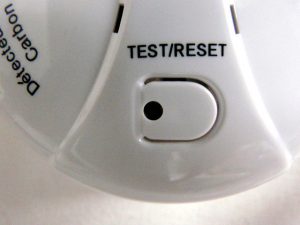An apartment building in Hobart, IN filled with carbon monoxide, the colorless, tasteless, odorless toxic gas, last month. Inside the building, there were two adults and one especially vulnerable three-month-old baby. They called the Hobart Fire Department when they were seeing high levels of carbon monoxide on their detector.
The fire department was able to confirm that there were high levels of the dangerous gas in the residence. The family was then transported to the hospital. All of them survived, but the baby narrowly escaped death.

Be sure your carbon monoxide detectors are working in your home this fall and winter. A working CO alarm may have saved this family’s life in Hobart, IN. (Flickr / Creative Commons / Judy van der Velden)
The owner of the building has been cited for several safety code violations by building inspectors following this incident. The residence reportedly does not even have heat at this time with winter approaching, according to reports in the Chicago Tribune article. It is unclear whether or not the family who survived moved back into the apartment where they were poisoned.
However, the Tribune reported that another family with a 14-month-old child lives in the same building where the poisoning occurred. This is concerning because carbon monoxide is especially dangerous to pets and small children.
(See our blog on carbon monoxide poisoning in pets.)
The bodies of pets and children are smaller, so the effects of the gas happen much quicker. The effects of carbon monoxide on a fetus are also magnified. The carboxyhemoglobin levels of a fetus can be ten to fifteen percent higher than the pregnant mother.
Carbon monoxide laws in Indiana don’t exist yet, but some residents are pushing for laws that require carbon monoxide detectors. In this case, the carbon monoxide detector did save the baby’s life, if not the whole family’s lives. The LOK Wishing Tree Foundation, named after a girl who was fatally poisoned from LaPorte, IN, is pushing for a law to pass that would require carbon monoxide detectors.
(See our blog on carbon monoxide laws in Indiana and Arizona.)
With daylight savings time comes the reminder to check your carbon monoxide detectors to make sure they are functioning properly. Replace or check the batteries in your CO alarms. This can literally be a lifesaver.

Leave a Reply
Want to join the discussion?Feel free to contribute!